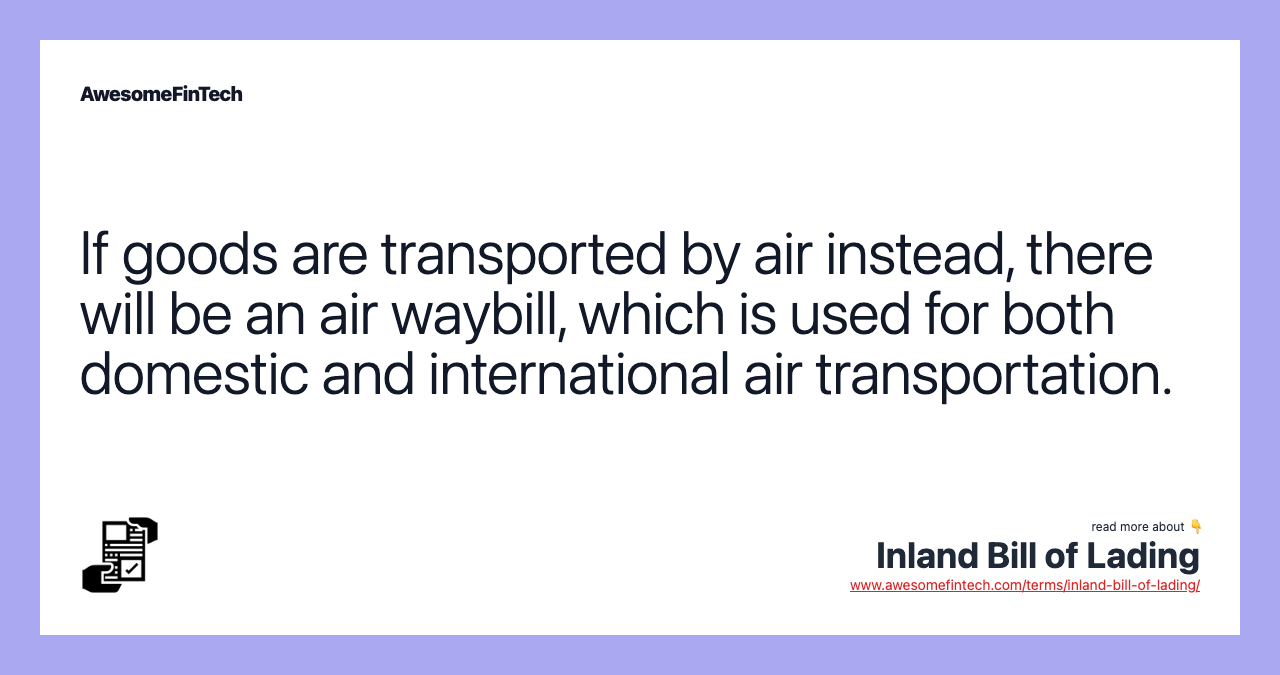Inland Bill of Lading
Some other bills of lading include a clean bill of lading, a direct bill of lading, a stale bill of lading, and a claused bill of lading. An inland bill of lading is often the first transportation document issued for an international shipment and is used to transport goods over land via rail, road, or inland waterway, to the point at which the exporter's international carrier can place it on a ship. An inland bill of lading is a contract signed between a shipper and a transportation company (carrier) for the overland transportation of goods. If an inland bill of lading is non-negotiable, it may only be delivered to the named consignee, but if it is negotiable, then the carrier in possession of the bill of lading may re-

What Is an Inland Bill of Lading?
An inland bill of lading is a contract signed between a shipper and a transportation company (carrier) for the overland transportation of goods. An inland bill of lading serves as both the carrier's receipt to the shipper and the carriage contract. The document specifies the details of the goods being transported.







Understanding an Inland Bill of Lading
An inland bill of lading is often the first transportation document issued for an international shipment and is used to transport goods over land via rail, road, or inland waterway, to the point at which the exporter's international carrier can place it on a ship.
It is the contract between the owner of the goods and the carrier, stating in detail a description of the goods, their value, their origin, destination, and the terms of their transportation. It will state the particular vehicle the goods are to be transported on and how freight charges are to be paid. The bill of lading serves as the receipt for the owner of the goods as well as the carrier's title for the purposes of transportation.
Because it is concerned with domestic overland transportation, the inland bill of lading will not be consigned directly to the foreign buyer of the goods but rather to a third party. This is usually the international carrier of the goods, but consignment to another third party, such as a warehouse, freight forwarder, or packaging company, before it reaches the international carrier is possible.
If consigned to such a third party, that party will, in turn, need to consign it to the international carrier. If an inland bill of lading is non-negotiable, it may only be delivered to the named consignee, but if it is negotiable, then the carrier in possession of the bill of lading may re-route the shipment.
Bill of Lading for Shipping Overseas
If the goods are to be shipped overseas, an additional document known as an "ocean bill of lading" is required. The inland bill covers only the domestic transportation component, while the ocean bill allows its transport overseas.
A full international shipment will thus require both an inland and an ocean bill of lading. The information contained in the inland bill of lading regarding the cargo should be reconfirmed by the international carrier. If there is a discrepancy between the cargo descriptions on the inland and ocean bills of lading, the latter will take precedence at the final destination.
If goods are transported by air instead, there will be an air waybill, which is used for both domestic and international air transportation.
Other Bills of Lading
Because the import/export business is vast with many moving parts, there are a variety of bills of lading. It is important to understand which ones you need when shipping or receiving goods, to avoid delays in delivery as well as to avoid financial loss in case goods are lost. Having an accurate bill of lading can help locate lost goods in the vast world of global shipments that move from one port to another around the globe, daily.
Some other bills of lading include a clean bill of lading, a direct bill of lading, a stale bill of lading, and a claused bill of lading.
Related terms:
Air Waybill (AWB)
An air waybill (AWB) is a document that accompanies goods shipped by an international air courier to provide detailed information about the shipment. read more
Bill of Lading
A bill of lading is a legal document between a shipper and carrier detailing the type, quantity, and destination of goods being shipped. read more
Claused Bill of Lading
A claused bill of lading shows a shortfall or damage in the delivered goods. It is also called a dirty bill of lading or foul bill of lading. read more
Clean Bill of Lading Defintion
A clean bill of lading is a document that declares there was no damage to or loss of goods during shipment. The clean bill of lading is issued by the product carrier after thoroughly inspecting all packages. read more
Consignment
Consignment is an arrangement wherein goods are left in the possession of another party, who sell the goods and take a piece of the profit. read more
Export
Exports are those products or services that are made in one country but purchased and consumed in another country. read more
Futures Exchange
A futures exchange is a central marketplace, physical or electronic, where futures contracts and options on futures contracts are traded. read more
Import
An import is a product or service produced abroad but then sold and consumed in your country. read more
Negotiable Bill of Lading
A negotiable bill of lading is a contract of carriage that can be transferred to a third party. read more
Ocean Bill of Lading
Learn more about the ocean bill of lading, a legal document required for the transportation of goods overseas between a shipper, carrier, and receiver. read more